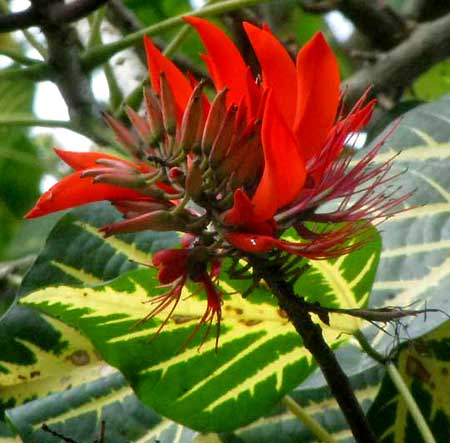

Here and there along streets and roads all through the Yucatan you see smallish trees with leaves boldly striped with yellow as shown at the right. It's the Indian Coral Tree, Erythrina variegata. The word "coral" is in its name because people call almost anything red "coral," and deep in the dry season, in February or so, the Indian Coral Tree does produce dense racemes of very red blossoms, as shown below:

Indian Coral Tree is a member of the Bean Family, so those 2½-inch-long (8cm), red flowers are typical bean-type blossoms except that the top petal, the "standard," is much oversized relative to the lower petals -- the "wings" and "keel."
Besides being pretty and easy-to-grow, in many cultures Indian Coral Trees are regarded as useful. In southern Florida they're often planted as hedges. In India they're used to support vine crops such as black pepper, vanilla, yam and betel. During the hottest months their leaves shade the vines, keeping them moist. When it gets cooler the leaves fall and the vines receive more direct sunlight, which is what they need at that season. Indian Coral Trees are popular shade trees in many places, and make excellent living fence posts. Their leaves make good feed for most livestock, containing 16-18% crude protein.
Medicinally, in Asia, juice from the tree's leaves is mixed with honey to kill tapeworms, roundworms and threadworms. Women take the juice to stimulate lactation and menstruation. A warm poultice of its leaves relieves rheumatic joints. The bark is used as a laxative, diuretic and expectorant. The Maya I've talked to don't know about these uses, which is to be expected, since this is a non-native tree that wasn't around as their traditions evolved.